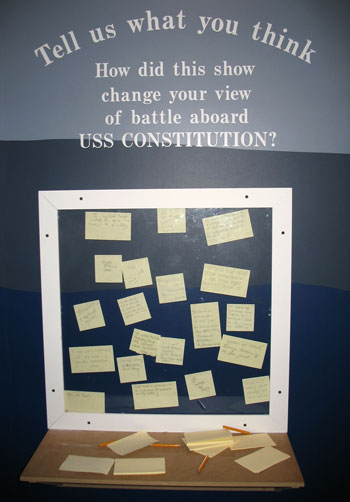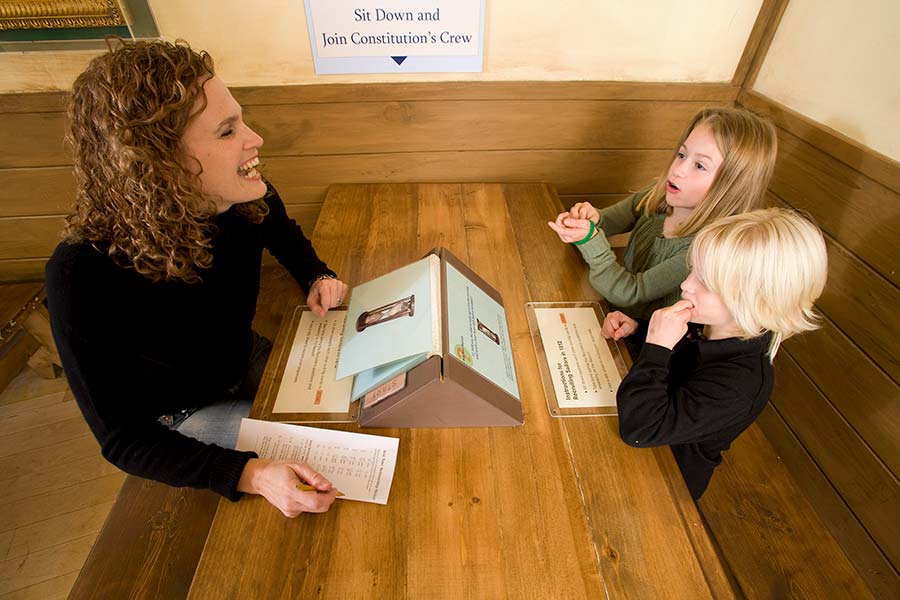Why it is Important
Family learning is a social experience. That means conversations are key to family learning. Family conversation sparks deeper shared understanding of the exhibit or program’s subject matter and provides families with the opportunity to learn about their family and each other.
Conversation about your content within a family group leverages the family’s shared understanding, language, and meaning. Family members are much better at communicating with one another than you can be at delivering ideas to each of them.
Put it into Practice
Use the design strategies on this website to encourage conversation. Multi-sided, multi-user, and multi-outcome experiences prompt opportunities for discussion through problem solving and teamwork. Relevant experiences encourage conversation by asking questions and making connections. These types of experiences are sure to get families talking and learning.
Encourage families to talk to one another by asking questions throughout the experience. Add discussion and reflection prompts to programs during transitions and other appropriate junctures. Try incorporating questions into exhibit text through panels or let visitors leave their thoughts on a comment board.
Add a Question to Labels
Posing a question is three times more likely to encourage visitor conversation than simply presenting information or a historic quotation. How do we know this? We tested it with our visitors.
The USS Constitution Museum wanted to identify questioning techniques that encourage family conversation in our exhibits, so we prototyped three types of labels. We asked if visitors preferred:
- A question that put them back in historical time, such as “What would you do if you were in this situation?”
- A contemporary question bridging past to present such as “Have you ever been in a similar situation?”
- An real historical quotation from a sailor
Three hundred families commented on label text in a pilot study before our prototype exhibit opened. Almost half of the family members interviewed preferred the historical quote labels. Visitors stated they preferred these quotes because the content was authentic, provided a personal connection, and gave historical perspective. One-third of visitors preferred the historical question, expressing that these questions fulfilled their need for thought-provoking content and that the questions’ open-endedness was more engaging. Fewer than two in ten visitors preferred the contemporary question.
What happened when visitors encountered these labels within the exhibit? Which were more effective at encouraging conversation? Museum staff observed over 550 visitors and recorded their behavior in tracking and timing behavioral studies. Visitors engaged in conversation with the historical question labels three times more often than with the historical quote labels.
This highlights the importance of using different research tools to understand visitor preferences and visitor behavior. These findings are not contradictory. A visitor may prefer to read a quote to learn about the past directly; however, if an exhibit developer’s aim is to encourage family conversations about the topic, the historical question is a much more powerful technique.
Use a Comment Board
Comment boards offer visitors an opportunity to share their thoughts and state their opinions. They make an exhibit more of a discussion rather than an authoritative presentation. Comment boards can also be very helpful tools for exhibit developers to see if key messages are reaching visitors. Positive comments not only motivate staff, volunteers, and board members, but also demonstrate the impact of the museum experience.
Determining the right questions to ask can be difficult. We have asked visitors, “What does CONSTITUTION mean to you?” and received many nice comments on the symbolic nature of the ship. After installing a 7-minute show about battle during the War of 1812 we asked visitors, “How did this show change your perception of battle at sea?” The comments were more nuanced and fell into a range of categories:
- Patriotic: Grateful to our military then and now
- Anti-war: War is an unnecessary waste of lives
- Pro-war: I think it would be cool to be a sailor on CONSTITUTION
- Empathetic: I wouldn’t want to serve on CONSTITUTION
- Museum comments: “Greater than Disney”
- Unrelated: (practice spelling four-letter words)
Month after month, our comment board prompted this same range of responses. We felt this was a healthy barometer of the show because it presented both the honor and brutality of war. Visitors’ responses were both positive and negative about the topic. Regardless of the question asked, a percentage of visitors will always comment on the museum experience in general, and there are some who just like to write inappropriate comments and post them in public. We often post a sample of the appropriate comments behind Plexiglas, with an area for today’s visitors to leave their comments.

Ask Questions During Programs
How does a facilitator encourage conversation and reflection? By asking the right questions. This is a tough skill to master, but doing so improves the quality of a family’s conversation. Address open-ended, non-binary questions to both adults and children to prompt family discussion.
Questions that make content relevant encourage conversation. In our Impress with a Quill Pen program, families can choose to fill out an “allotment” form, an agreement that the Navy will automatically send a percentage of a sailor’s wages home. We ask kids and adults if they would send their wages home. This gets caregivers and kids talking about why or why not they would send money home, what role kids today have in helping to support their families, and how different life was 200 years ago.
As Beth Fredericks explains, sometimes simple reflective questions, such as “what do you think…?” or “have you ever…?,” help participants make connections, and subsequently make meaning, of the activity:
Marianna Adams gives one example of how a facilitator can provoke conversation:
